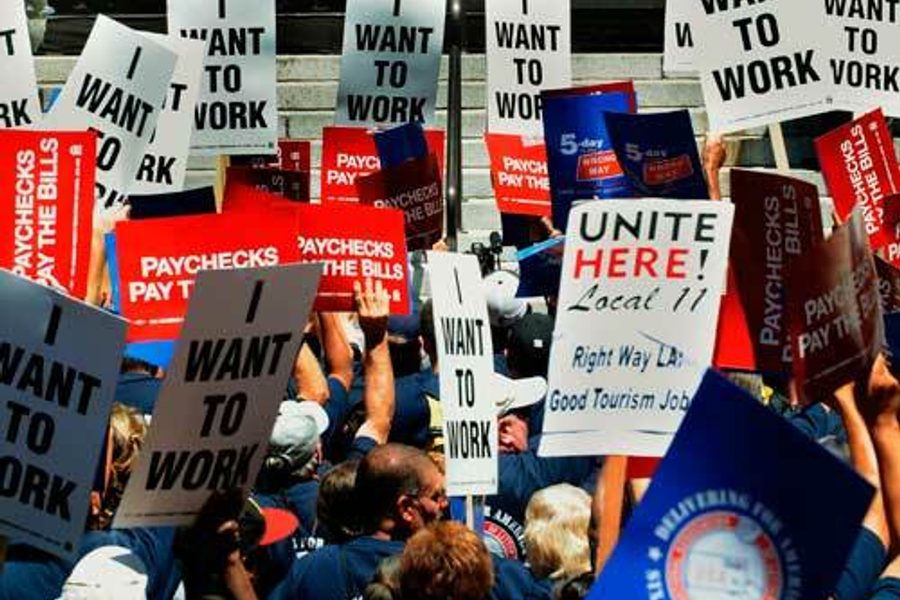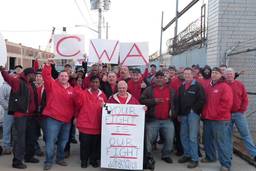It’s starting to look more fact than fiction, at least in New York City
Last week, the conservative pundit William McGurn wrote in the Wall Street Journal of a coming class war between public sector union members and private sector union members who “notice that their job prospects are at risk from public-employee union contracts.”
Indeed, there does seem to be a growing resentment of union workers in the United States as other workers’ standards of living decrease. but are we at the point of a class war between these two sectors or is this just some conservative fantasy? Sure, some members of the working class might grow resentful of union members, but would private sector union members actually attack public sectors unions?
A look at what is happening in New York City indicates that such a class war between private and public sector unions might be brewing. With more than 1 million unions members living in New York City and with nearly 25% of the city’s population belonging to a union, New York City has a higher rate of unionization than any other city in the United States, according to the Bureau of Labor Statistics. thus you might expect solidarity between different unions to be greater since so many union members live in New York City.
However, Gary LaBarbera, the president of the Building and Construction Trades Council of New York recently signed on to the Committee to Save New York, a coalition of business and real estate executives that seek to raise $10 million to raise a campaign in support of incoming New York Governor Andrew Cuomo’s plan to take on government employees in New York State by cutting wages and pensions.
Several New York City labor activists who spoke off the record said that LaBarbera is willing to take on public employees over pay and wages in order to free up money from the state budgets to go toward construction projects. Increasingly, states are cutting back on massive construction and infrastructure projects in order to pay for their wage and pension obligations. With unemployment at nearly 40% among unionized construction workers in New York City, construction union leaders are under pressure to find jobs for their members or risk becoming financially insolvent as unions.
The unions in New York City have long feuded over funding priorities and other political issues tied to development projects. Most recently in 2010, the retail workers union, RWSDU, successfully stopped the construction of the Kingsbridge shopping development in Queens because the city would not guarantee that the jobs created by that development would pay a living wage.
Meanwhile, the construction unions supported this project development because it would have employed hundreds of their members. The fight over the Kingsbridge development project and many other development projects has broken ties of solidarity, putting unions in New York City desperately seeking good jobs for their membership at odds with one another.
LaBarbera, who could not be reached for comment for this story, dismissed in the New York Times claims though that he is aligning with opponents of public employees unions in order to win more government construction contracts for his workers. “We’re advocating for a fiscally sane economy in New York,” Mr. LaBarbera told the Times. “This is not about bashing public-sector unions. But without a fiscally sound environment, we will not be able to attract new businesses to the city; we’ll continue to lose business.”
To many observers of the right wing attacks on organized labor, it would seem foolish for constructions unions to attack public employees unions in order to win more construction projects. After all, the right wing union busting establishment has also sent its sights on abolishing construction union favored project labor agreements. These projects labor agreements make it more competitive for unionized construction contractors to bid on unions by setting wage standards on what bids will be reviewed (ITT wrote on the right-wing attack on project labor agreements back in November). If construction unions helped fuel right wing attacks on the high wages of public employees, wouldn’t they also help to fuel the sentiments behind similar attacks on the high wages of workers employed on these governmental project labor agreements?
“We have to absolutely defend the public sector” says former New York City Central Labor Council Executive Director Ed Ott. “It’s not good to say they took us down, now we should take them down. I don’t think any labor leader should do that, but Gary LaBarbera claims that is not what he is doing. It’s unclear what his motives are. The next few days will be very telling. However, tensions are very high in the labor movement in New York City.”
While it’s unclear what New York City Build Trade leader LaBarbera’s motives are, Ott argues that it’s crucial for a great sense of solidarity between all unions. “We have been getting our asses kicked as a labor movement. One of the last organized components is the public sector, where we have some density and workers still have some rights. We as a labor movement must defend them.”
“Likewise, public sector unions must provide resources to help organize in the private sector; otherwise, with such a large non-unionized workforce envious of their working standards, they are almost certain to come under attack,” says Ott.
Public sector unions, who now account for nearly half of the 15 million union members in the United States, had traditionally struck to help organize within their jurisdiction. Although increasingly public sector union leaders, who represent 37% of all publc employees, are talking about ways they can help the private sector, which has dwindled to 7% according to the Bureau of Labor Statistics. Public sector unions provided massive financial support in the tens of millions of dollars to help pass the Employee Free Choice Act, even though public sector workers can already vote in union elections free of management intimidation.
With the right wing attempting to divide the non-unionized working class from the unionized working class over the issue of public sector unions, many say it’s crucial for unions not to open themselves up to the divide and conquer tactics.
“We are at a moment where a movement has lost its compass, everybody is under pressure, people don’t know if they should defend others in the labor movement,” says Ott. “Some people in the labor movement feel maybe they should make a separate peace when they feel the movement is weak. However, if we let the public sector go down without a fight, we’re taking a poison pill as a labor movement in this country.”









